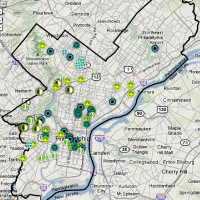Philly’s Green Approach to Stormwater Pollution Draws National Spotlight

Popular Mechanics looked at Philadelphia’s unique approach to taking on the stormwater challenges that cities across the U.S. face. Credit: Popular Mechanics
This month’s Popular Mechanics magazine features a story that paints a striking picture of the challenges Philadelphia faces when it comes to fighting stormwater pollution. If the descriptions provided by the author disturb you, it’s because they should—after all, we’re not spending billions of dollars over 20 years through the Green City, Clean Waters program for nothing.
Stormwater and sewer overflows are the biggest source of pollution impacting our rivers today, and we take that seriously.
And, while there are 193 other U.S. cities facing similar issues with sewer overflows, we’re the first to address the problem with a green infrastructure approach that will add 19 square miles of green space to our neighborhoods while keeping 9 billion gallons of stormwater and sewage out of our rivers each year.
We’re proud of the fact that we’re on pace to exceed our green infrastructure target in 2016, which, as the article notes, is expected to reduce sewer overflows by more than 1 billion gallons each year. That’s just in the first 5 years of the 25-year program, and we’re planning to seriously ramp up our efforts in the next 5 years to meet even more ambitious targets.
As Mike Helbing, of the environmental advocacy group PennFuture tells Popular Mechanics, Green City Clean Waters is helping our rivers while giving us “more trees, shade, recreation areas and a better aesthetic in a city.”
"It's not only increased the environmental quality of the city, but it has economic benefits," Helbing says. "This is a less costly way of addressing the problem."
You can read the full Popular Mechanics story by clicking here.





